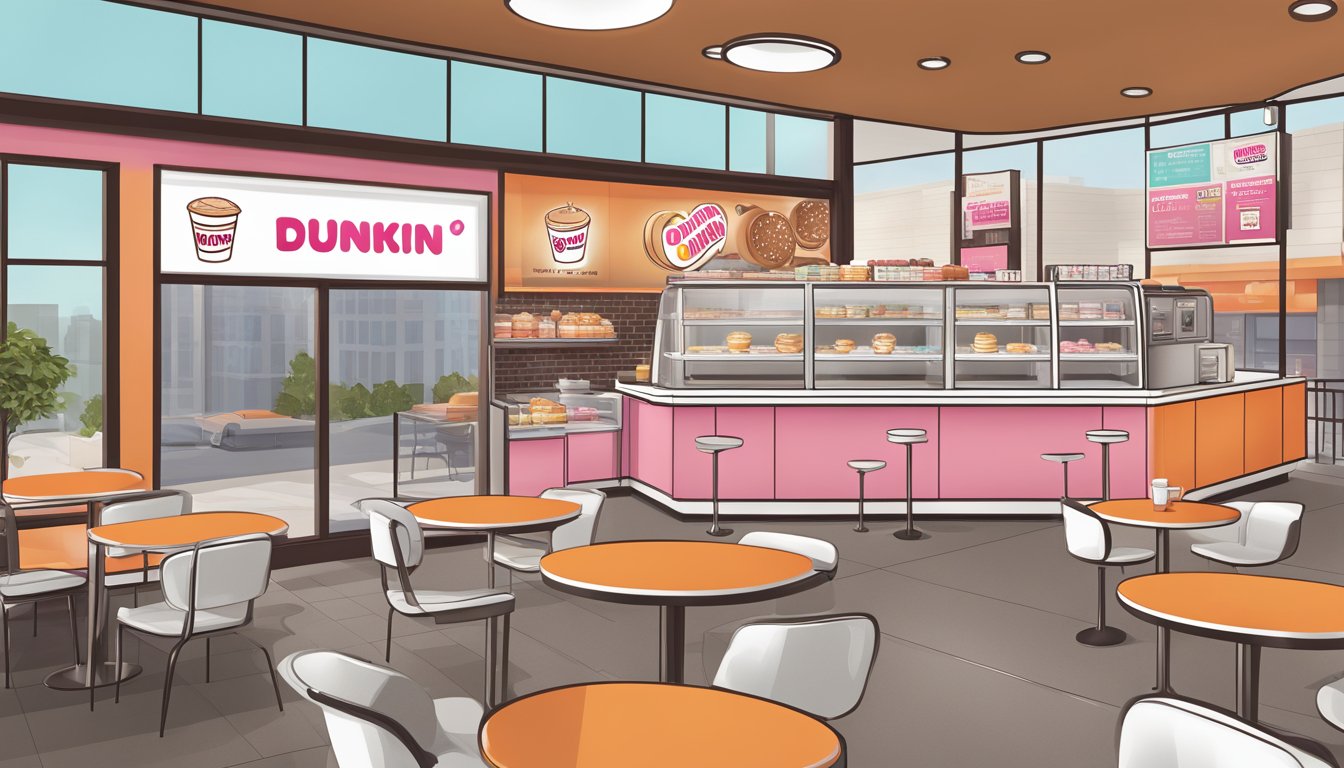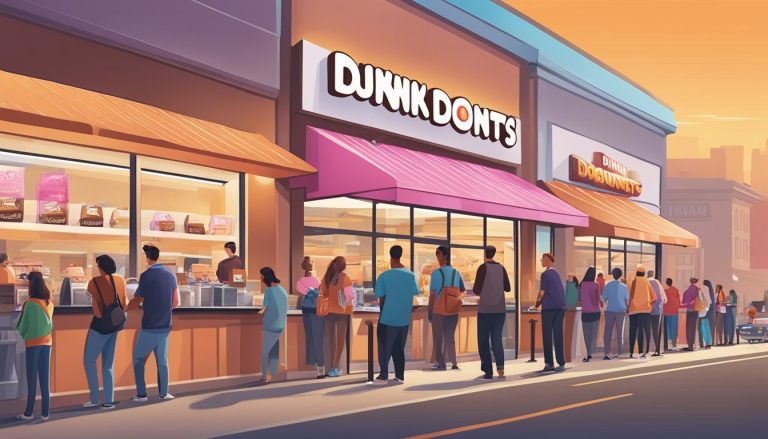Dunkin’, the iconic coffee and baked goods chain, has mastered the art of balancing tradition and innovation in its marketing strategy. Since its founding in 1950, the company has evolved from a simple donut shop to a global powerhouse in the quick-service restaurant industry. Dunkin’s approach combines honoring its roots while embracing change, allowing it to stay relevant in a constantly shifting market.
The brand’s success stems from its ability to maintain core offerings while introducing new products and experiences. Dunkin’ continues to serve its classic coffee and donuts, satisfying longtime customers who associate the brand with comforting traditions. Simultaneously, it expands its menu to include healthier options and trendy beverages, appealing to modern consumers with diverse tastes and dietary preferences.
Dunkin’s marketing reflects this dual focus. The company retains its familiar “America Runs on Dunkin'” slogan, reinforcing its established place in American culture. At the same time, Dunkin’ leverages digital platforms and innovative campaigns to engage younger audiences and showcase its adaptability. This strategic blend of nostalgia and forward-thinking has positioned Dunkin’ as a brand that respects its heritage while confidently stepping into the future.
The Heritage of Dunkin’: A Story of Coffee and Donuts

Dunkin’ has cultivated a rich legacy centered around its coffee and donuts since 1948. The brand’s journey from a local shop to a global powerhouse reflects its ability to maintain tradition while embracing change.
Establishing Brand Identity
Dunkin’ began as “Open Kettle” in Quincy, Massachusetts, serving donuts for five cents and premium coffee for ten cents. In 1950, founder William Rosenberg renamed it “Dunkin’ Donuts” after a brainstorming session with executives. This name change marked the beginning of a distinct brand identity.
The company’s commitment to fresh, high-quality products set it apart. Dunkin’ offered over 50 varieties of donuts, catering to diverse customer preferences. This wide selection became a hallmark of the brand.
As Dunkin’ expanded, it maintained its focus on coffee and donuts while adapting to changing consumer tastes. The 1990s saw coffee take center stage, with the brand expanding its beverage offerings to compete with premium coffee chains.
The Significance of ‘America Runs on Dunkin’
In 2006, Dunkin’ introduced the slogan “America Runs on Dunkin’.” This tagline encapsulated the brand’s role in American daily life and its perception as a fuel for productivity.
The slogan resonated with customers, emphasizing Dunkin’s convenience and reliability. It positioned the brand as an essential part of Americans’ routines, from morning commutes to afternoon pick-me-ups.
“America Runs on Dunkin'” also highlighted the brand’s national presence and its connection to American culture. This messaging helped solidify Dunkin’s place as a beloved institution in many communities across the country.
Evolution of the Dunkin’ Logo
Dunkin’s logo has undergone several transformations since its inception, each reflecting the brand’s growth and changing focus.
The original logo featured a stylized coffee cup with the full name “Dunkin’ Donuts” in a playful font. This design emphasized both key products – coffee and donuts.
In 2019, the company rebranded as simply “Dunkin’,” dropping “Donuts” from its name and logo. This change aimed to highlight Dunkin’s expanded beverage offerings beyond just coffee.
The current logo maintains the brand’s signature pink and orange colors, preserving a visual connection to its heritage. The simplified design reflects Dunkin’s evolution into a modern, beverage-led brand while honoring its donut-shop roots.
Navigating Market Dynamics

Dunkin’ employs strategic approaches to understand and adapt to evolving market conditions. The company focuses on consumer insights, preference shifts, and data-driven marketing to stay competitive in the fast-paced food and beverage industry.
Understanding the Customer Base
Dunkin’ recognizes the importance of knowing its diverse customer base. The company segments customers by age, lifestyle, and purchasing habits. This allows for targeted marketing and product development.
Millennials and Gen Z form a significant portion of Dunkin’s audience. These groups value convenience and digital engagement. In response, Dunkin’ has enhanced its mobile app and rewards program.
Regular customers, often stopping by for their daily coffee, remain a core focus. Dunkin’ maintains consistency in its classic offerings while introducing new items to keep them interested.
Adapting to Consumer Preferences
Dunkin’ stays attuned to changing consumer tastes and health trends. The company has expanded its menu to include healthier options like egg white sandwiches and almond milk alternatives.
Plant-based foods have gained popularity. Dunkin’ introduced the Beyond Sausage Sandwich to cater to this growing market segment.
Seasonal flavors and limited-time offerings create excitement and drive foot traffic. Pumpkin spice and holiday-themed items are examples of Dunkin’s seasonal strategy.
Research-Driven Marketing Strategies
Dunkin’ relies on extensive market research to inform its marketing decisions. The company uses surveys, focus groups, and social media listening to gather consumer insights.
Data analytics play a crucial role in Dunkin’s marketing efforts. The company analyzes purchase patterns and customer feedback to refine its promotional strategies.
Dunkin’ leverages its loyalty program data to personalize offers and communications. This approach increases customer engagement and drives repeat visits.
Digital marketing channels, including social media and influencer partnerships, are key components of Dunkin’s strategy. These platforms allow for real-time engagement and trend participation.
The Innovation Imperative
Dunkin’ recognizes the critical need to innovate in order to stay competitive and meet evolving customer preferences. The company focuses on three key areas to drive innovation forward while maintaining its core identity.
Driving Menu Innovation
Dunkin’ regularly updates its menu to keep offerings fresh and exciting. New seasonal flavors for donuts and beverages are introduced throughout the year. The company also experiments with limited-time items to gauge customer interest.
Health-conscious options like egg white sandwiches and plant-based proteins have been added to appeal to changing dietary preferences. Dunkin’ has expanded its drink menu beyond coffee, introducing cold brew, energy drinks, and tea options.
Menu boards are optimized using data analytics to highlight popular items and promote new offerings effectively. This helps drive sales of innovative products while maintaining strong performance of classic menu staples.
Leveraging Digital Marketing
Dunkin’ embraces digital technology to connect with customers and drive engagement. The DD Perks loyalty program allows personalized offers and rewards through a mobile app. This encourages repeat visits and provides valuable customer data.
Social media campaigns showcase new products and leverage user-generated content. Influencer partnerships help create buzz around menu innovations. Geotargeted mobile ads drive foot traffic to nearby locations.
The company uses artificial intelligence to optimize marketing spend and tailor messaging to individual customers. This data-driven approach ensures marketing efforts resonate with target audiences.
Product Innovation and Design
Dunkin’ invests in product development to create unique offerings. The company’s culinary team works to craft new recipes that align with current food trends while maintaining brand consistency.
Packaging innovations focus on sustainability and convenience. Reusable cups and biodegradable materials reduce environmental impact. On-the-go packaging designs cater to busy customers seeking portability.
Store layouts are periodically refreshed to improve customer flow and highlight new products. Digital menu boards allow for dynamic pricing and easy menu updates. Self-service kiosks in some locations provide ordering flexibility and reduce wait times.
Strengthening Customer Connections

Dunkin’ has implemented strategic initiatives to forge stronger bonds with its customers. These efforts focus on enhancing experiences, building loyalty, and leveraging technology to meet evolving consumer needs.
Enhancing the Customer Experience
Dunkin’ prioritizes creating positive interactions at every touchpoint. The company has renovated store layouts to improve efficiency and comfort. Digital menu boards now display customized offerings based on time of day and local preferences. Streamlined drive-thru systems reduce wait times, while mobile ordering allows customers to skip the line entirely.
Staff undergo extensive training in customer service skills. Employees are encouraged to greet regulars by name and remember their usual orders. This personalized approach helps foster a sense of community and belonging among patrons.
Dunkin’ also solicits and acts on customer feedback through surveys and social media. This data informs menu updates and operational improvements to better meet customer expectations.
Building a Loyal Customer Base
Dunkin’ employs various tactics to cultivate customer loyalty. The company offers a range of promotions, such as “Free Donut Fridays” and seasonal specials, to reward frequent visitors. These limited-time offers create a sense of urgency and encourage repeat purchases.
The brand maintains an active social media presence, engaging with followers through contests, polls, and behind-the-scenes content. This two-way communication helps build emotional connections with customers.
Dunkin’ also partners with local organizations and sponsors community events. These initiatives demonstrate the company’s commitment to the neighborhoods it serves, fostering goodwill and brand affinity among residents.
The Role of the Mobile App and Loyalty Program
Dunkin’s mobile app serves as a central hub for customer engagement. It allows users to place orders, pay, and earn rewards seamlessly. The app’s location-based features send personalized offers when customers are near a store, driving foot traffic and sales.
DD Perks, Dunkin’s loyalty program, incentivizes repeat business through a points-based system. Members earn points on purchases, which can be redeemed for free beverages and food items. The program also offers exclusive perks like birthday rewards and early access to new products.
The app and loyalty program provide valuable data on customer preferences and behaviors. Dunkin’ uses these insights to tailor marketing campaigns and develop new menu items that align with consumer trends.
Strategic Brand Initiatives
Dunkin’ has implemented several key initiatives to modernize its brand while maintaining its core identity. These efforts focus on evolving the company’s image, forming strategic alliances, and tailoring marketing approaches to local markets.
Rebranding Efforts for Modern Times
In 2019, Dunkin’ dropped “Donuts” from its name to emphasize its broader menu offerings. This rebranding aimed to position Dunkin’ as a beverage-led, on-the-go brand. The company updated its logo, store designs, and packaging to reflect a more modern aesthetic.
New store concepts feature digital kiosks and mobile order pick-up areas. These changes cater to the evolving preferences of younger consumers who value convenience and speed.
Dunkin’ also revamped its menu to include healthier options and trendy items like cold brew coffee and plant-based alternatives. This menu diversification helps attract a wider customer base while retaining loyal patrons.
Collaborations and Strategic Partnerships
Dunkin’ has forged partnerships with various brands to expand its reach and appeal. Collaborations with companies like Saucony for running shoes and e.l.f. Cosmetics for makeup collections generate buzz and attract new customers.
The brand has also partnered with food delivery services like Grubhub and DoorDash to increase accessibility. These partnerships have become especially valuable in recent years as demand for delivery services has surged.
Celebrity endorsements play a role in Dunkin’s strategy. Partnerships with influencers and celebrities like Charli D’Amelio have helped the brand connect with younger audiences and boost engagement on social media platforms.
Localizing the Global Marketing Strategy
Dunkin’ adapts its global marketing strategy to suit local tastes and preferences in different markets. This approach allows the brand to maintain its core identity while resonating with diverse customer bases.
In Asia, Dunkin’ offers region-specific menu items like Mochi Rings in Singapore and Pork Floss Donuts in China. These localized offerings help the brand compete with local competitors and cater to regional palates.
The company also tailors its marketing messages and campaigns to align with local cultural norms and values. This localization extends to store designs, which often incorporate elements of local architecture and aesthetics to create a familiar and welcoming environment for customers.
Building an Effective Online Ecosystem
Dunkin’ has developed a robust digital presence to engage customers and drive brand loyalty. The company leverages various online platforms and strategies to create a cohesive digital experience.
Amplifying Digital Engagement
Dunkin’ focuses on creating a seamless online experience for customers. The company’s mobile app allows users to order ahead, pay, and earn rewards. This digital tool enhances convenience and encourages repeat visits.
The brand’s website offers nutritional information, store locators, and promotional content. Dunkin’ regularly updates its online menu, showcasing new products and limited-time offers.
Email marketing campaigns keep customers informed about promotions, seasonal items, and loyalty program benefits. These targeted messages help maintain customer interest and drive sales.
Social Media Tactics
Dunkin’ maintains active profiles on major social media platforms. The brand uses a mix of promotional content, user-generated posts, and engaging visuals to connect with followers.
Facebook and Instagram serve as primary channels for sharing product images and promotional offers. Twitter is used for real-time customer service and quick updates.
The company runs social media contests and encourages customers to share their Dunkin’ experiences using branded hashtags. This strategy boosts engagement and creates a sense of community among fans.
Utilizing Social Media Influencers
Dunkin’ collaborates with influencers to expand its reach and credibility. The brand partners with lifestyle bloggers, food enthusiasts, and local personalities to promote products and campaigns.
Influencer partnerships often involve product launches or limited-time offers. These collaborations generate buzz and drive traffic to Dunkin’ locations.
The company carefully selects influencers who align with its brand values and target audience. This ensures authentic promotion and resonates with potential customers.
Operational Excellence and Expansion
Dunkin’ has built its success on a foundation of operational efficiency and strategic growth. The company’s approach balances streamlined processes with market expansion to deliver consistent quality and convenience to customers worldwide.
The Quick-Service Restaurant Model
Dunkin’ exemplifies the QSR model with its focus on speed and convenience. The company’s stores are designed for efficient service, featuring optimized layouts and well-trained staff. Drive-thru options and mobile ordering further enhance customer convenience.
Dunkin’ strategically locates its stores in high-traffic areas, ensuring easy access for commuters and busy customers. This accessibility is a key driver of the brand’s success in the competitive QSR market.
The company’s menu is carefully crafted to balance variety with operational simplicity. Core offerings like coffee and donuts are complemented by seasonal items, allowing for both consistency and novelty.
Formulating a Pricing Strategy
Dunkin’ employs a value-based pricing strategy that aligns with its brand positioning. The company offers competitively priced products while maintaining quality, appealing to cost-conscious consumers.
Menu pricing is tailored to local markets, considering factors such as competition, demographics, and operating costs. This flexible approach allows Dunkin’ to remain profitable across diverse locations.
The company leverages technology to implement dynamic pricing, adjusting prices based on demand and time of day. This strategy optimizes revenue while ensuring customer satisfaction.
Loyalty programs and promotions are integral to Dunkin’s pricing strategy, encouraging repeat visits and increasing customer lifetime value.
Global Expansion and Market Adaptation
Dunkin’ has successfully expanded its footprint beyond the United States, adapting its business model to suit local tastes and preferences. The company’s international growth strategy focuses on partnering with local franchisees who understand regional markets.
In new markets, Dunkin’ modifies its menu to include local flavors and ingredients. For example, in India, the company offers spiced tea and vegetarian options to cater to local preferences.
The brand maintains consistency in its core offerings while allowing flexibility in store design and marketing to resonate with local cultures. This approach has enabled Dunkin’ to establish a strong presence in diverse markets across Asia, Europe, and the Middle East.
Dunkin’ carefully selects expansion targets, prioritizing markets with growing middle classes and increasing demand for Western-style coffee and baked goods.
Community and Environmental Considerations

Dunkin’ balances its growth with responsibility towards communities and the environment. The company focuses on sustainability, ethical sourcing, and local engagement initiatives.
Fostering Community Engagement
Dunkin’ actively participates in local communities through various programs. The company partners with food banks and charitable organizations to donate surplus food. Franchisees often sponsor local sports teams and events.
Dunkin’ also runs the Joy in Childhood Foundation, which provides grants to children’s hospitals and food banks. In 2024, the foundation donated over $5 million to support children facing hunger and illness.
The company encourages employee volunteerism through paid time off for community service. This initiative resulted in over 50,000 volunteer hours in 2024.
Commitment to Sustainable Coffee Practices
Dunkin’ has pledged to source 100% of its coffee responsibly by 2025. The company works directly with farmers to improve growing practices and ensure fair wages.
Key initiatives include:
- Partnering with the Rainforest Alliance for certification
- Investing in farmer training programs
- Supporting women coffee growers through microloans
By 2024, Dunkin’ had achieved 85% responsibly sourced coffee. The company aims to reach its 100% goal ahead of schedule.
Eco-Friendly Packaging Innovations
Dunkin’ is transitioning to more sustainable packaging options. The company has eliminated foam cups, replacing them with double-walled paper cups. This change removed approximately 1 billion foam cups from the waste stream annually.
Other packaging improvements include:
- Recyclable lids for cold drinks
- Napkins made from 100% recycled materials
- Bagel bags with 100% recycled content
Dunkin’ is also testing reusable cup programs in select markets. Customers receive discounts for bringing their own cups, encouraging sustainable habits.
Conclusion: The Future of Dunkin’

Dunkin’ stands poised for continued success in the evolving coffee landscape. The brand’s strategic shift from donuts to coffee emphasizes its commitment to meeting changing consumer preferences.
Dunkin’s balance of tradition and innovation sets it apart in a competitive market. While maintaining its iconic pink and orange branding, the company embraces new technologies and menu offerings to stay relevant.
The focus on coffee leadership positions Dunkin’ as a serious contender in the specialty coffee arena. This move aligns with growing consumer demand for high-quality, customizable coffee options.
Digital initiatives, including mobile ordering and loyalty programs, cater to tech-savvy customers. These innovations streamline the customer experience and foster brand loyalty.
Menu diversification beyond traditional offerings appeals to health-conscious consumers. This strategy ensures Dunkin’ remains a go-to option for a wide range of dietary preferences.
Dunkin’s rebranding efforts signal its intent to be perceived as more than just a donut shop. The company aims to solidify its place as a comprehensive beverage and food destination.
By adapting to evolving coffee culture while honoring its roots, Dunkin’ is well-equipped to thrive in the future of quick-service dining.




